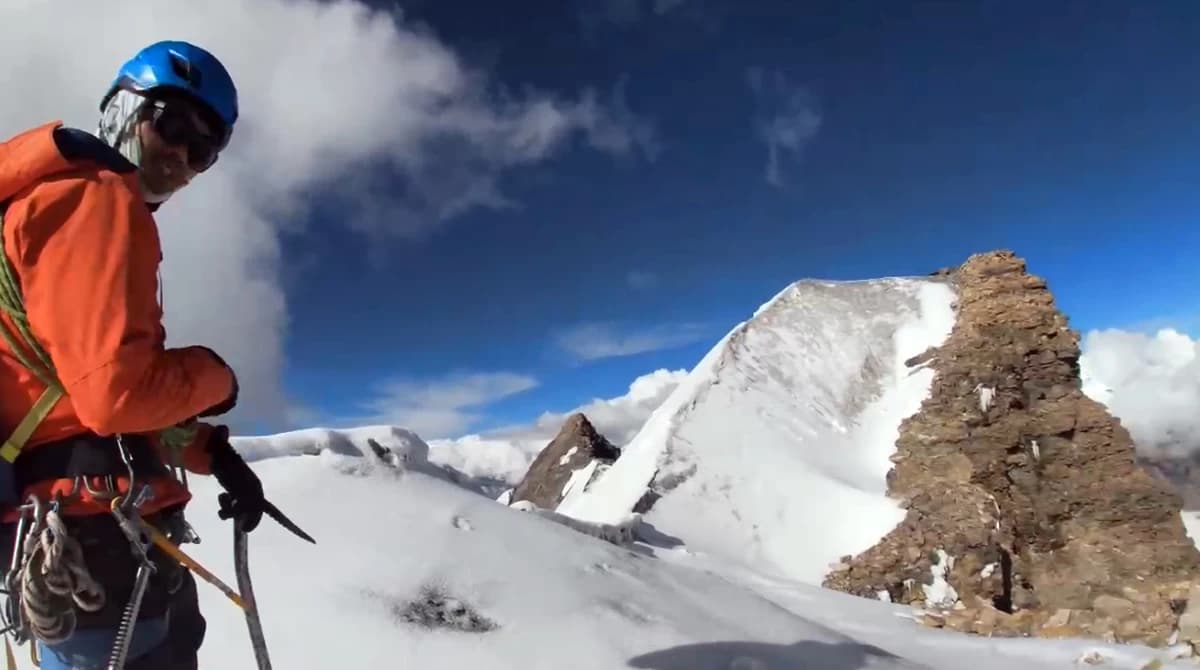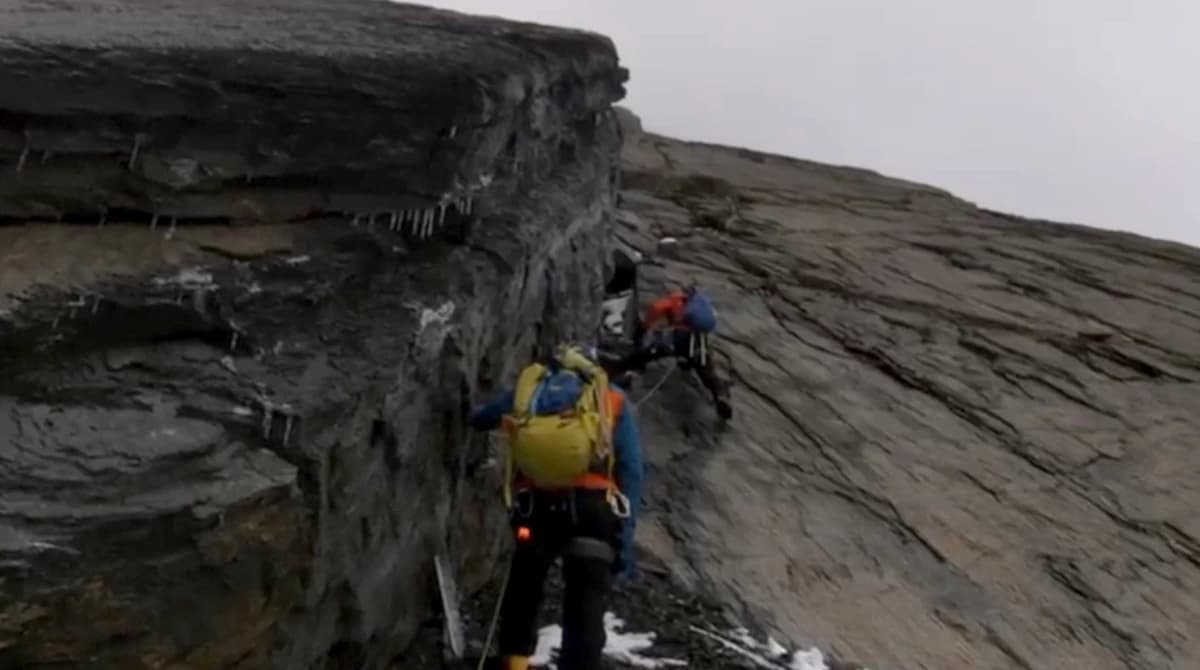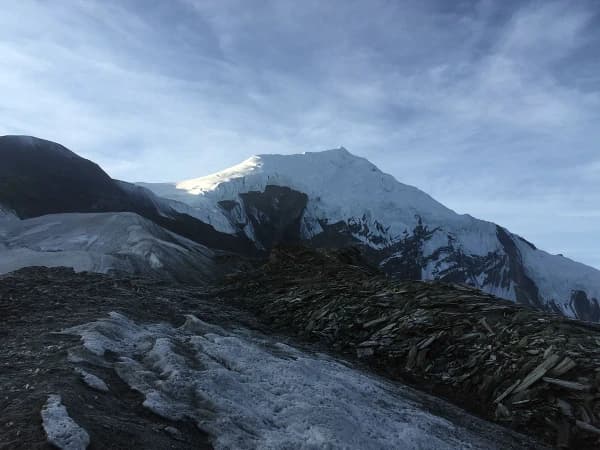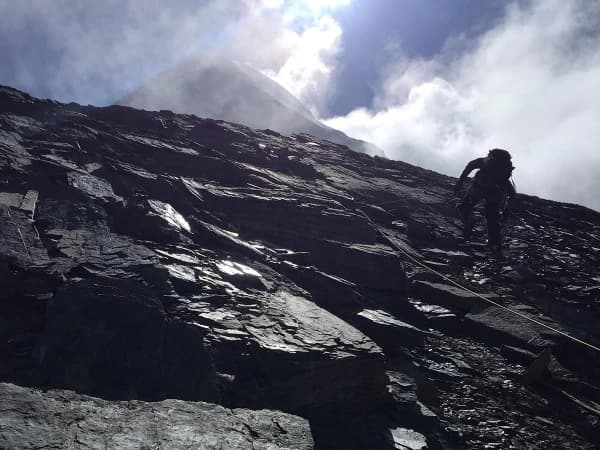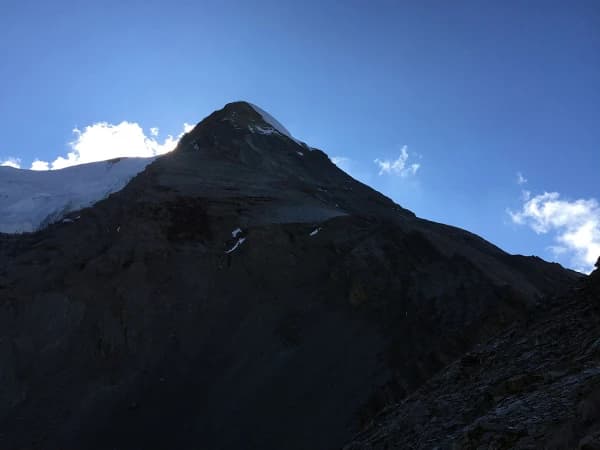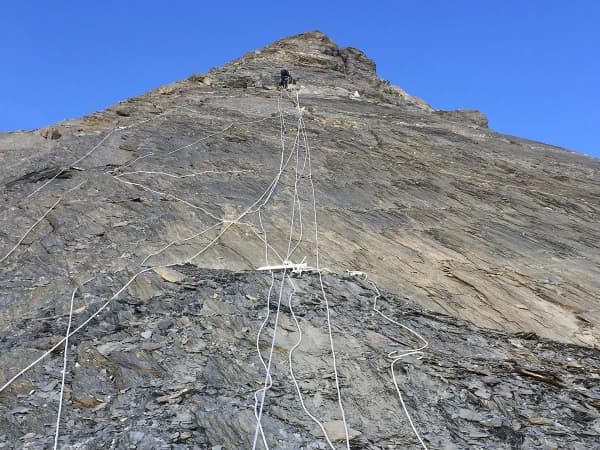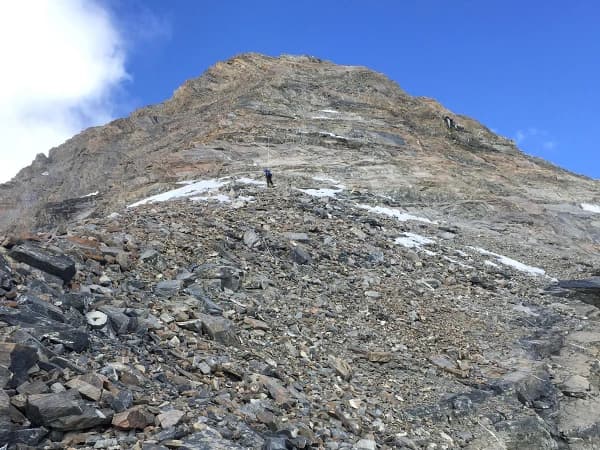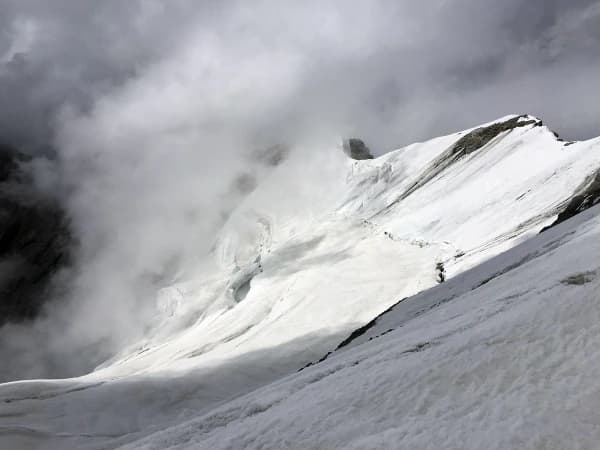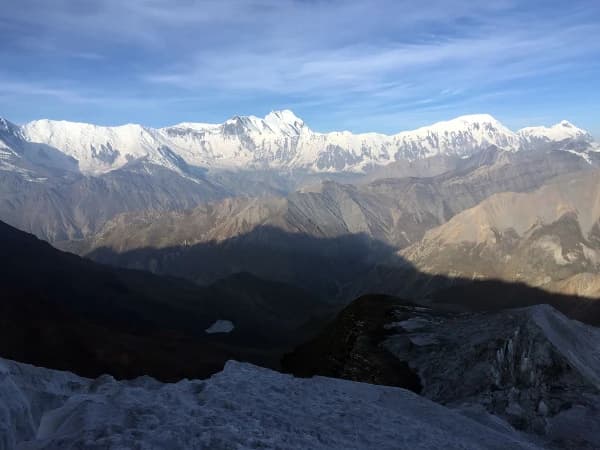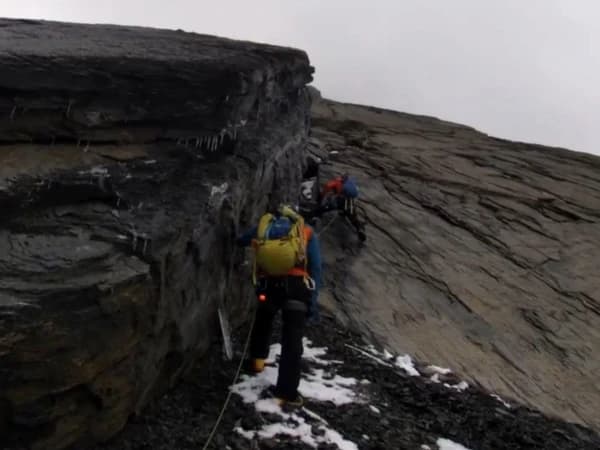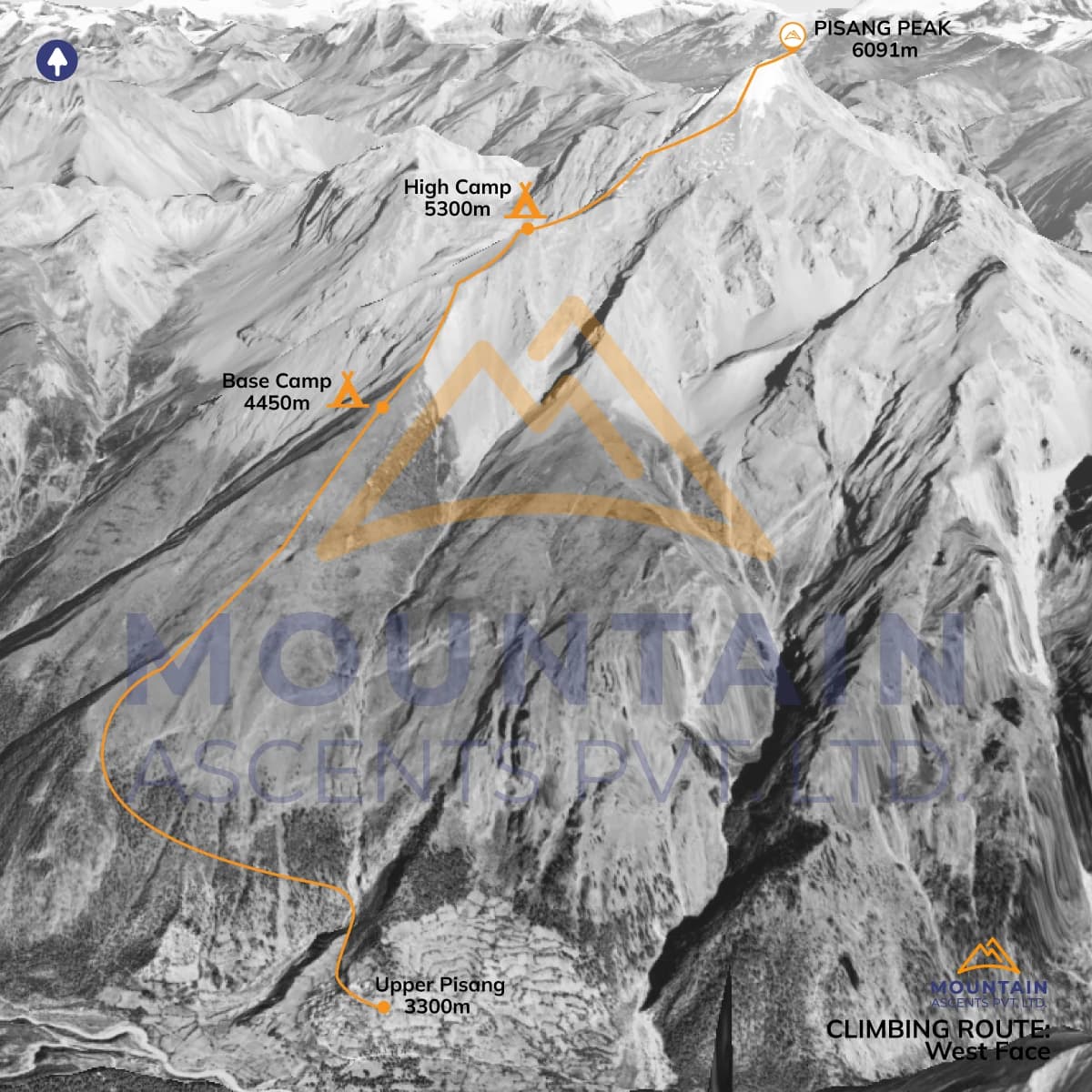Pisang Peak Climbing is one of the most accessible climbing expeditions in the Annapurna Himalayas of Nepal. Also known as Jong Ri, situated at an altitude of 6,091 m/19,984 ft, the Pisang Peak is famous for stunning views of the Annapurna, Manaslu, and other magnificent mountain ranges, unspoiled scenery, and authentic trekking and climbing excursions offering a once in a lifetime experience to behold.
Located in the spectacular Manang district of Nepal, beginners can undertake the moderately difficult non-technical peak with proper preparation, training, and good physical fitness. For experienced climbers and mountaineers, the Pisang Peak expedition is the best way to put a testament to oneself before attempting to summit more technical and challenging mountains such as the seven thousanders like Mt. Baruntse (7,129 m) or even the eight thousanders like Mt. Manaslu (8,163 m/the eighth highest mountain peak in the world) and the top of the world itself, Mt. Everest (8,848 m).
Usually, the climbing journey to Pisang Peak begins from the lively city of Kathmandu and takes you through the beautiful village of Chame, Upper Pisang, on your way to Pisang Base Camp. Next, trekkers and climbers make their way up to High Camp to begin the final ascent to Pisang Peak's summit. You will pass through lush forests that are home to a wide variety of flora and fauna, as well as through stunning alpine valleys and snow-capped mountains. In this forest of chir, juniper, and oak trees, adorned with vivid rhododendron flowers, you may spot the red panda, the elegant blue sheep, and the elusive snow leopard.
To conclude, Pisang Peak, with its moderate difficulty rating, offers climbers of all ability levels the chance to put their climbing abilities to the test while taking in breathtaking views of the Annapurna and Manaslu ranges, among other magnificent peaks. As the mountain’s location itself is majestic, the view Pisang Peak’s ascent offers is unsurpassable. The mighty Annapurna range extends from south to west. Dhaulagiri massif lies towards the far west. Towards the north lie the iconic villages of Nar and Phu. Towards east to northeast are the peaks of Himlung, Nemjung, Himjung, Kanguru, etc. And finally, towards south-east to south are the Manaslu mountains and the lowlands of Manang.
Trip Highlights
- Experience the authentic lifestyle of Nepalese people in both the city and the remote Himalayas.
- Take a guided UNESCO World Heritage Sightseeing Tour in the Kathmandu Valley, such as to Pashupatinath, Swayambhunath, Boudhanath, and the three cities ancient royal palaces, including Patan, Bhaktapur, and Basantapur.
- Enjoy a scenically abundant drive to Besisahar and Chame later on.
- An opportunity to receive an insider insight into the daily life of locals following Buddhism's unique culture, traditions, customs, and warm hospitality.
- Mander around the traditional villages of Besisahar, Chame, Upper Pisang, Pisang, and so on.
- Witness the allure of snow-clad Himalayan peaks such as the Annapurna ranges, Manaslu, and Pisang Peak itself.
- Summit enthralling 6,091 m Pisang Peak, providing a true sense of adventure and achievement, and others.
What makes Pisang Peak Climbing special?
Pisang Peak Climbing is a rewarding journey in the Annapurna region, standing out as one of the best alternatives to some more popular trekking and hiking peaks in the Everest Himalayas with an equally gratifying experience. Offering a pleasing blend of remote Himalayan trekking and climbing that charms both beginner and seasoned climbers, the journey is more than about summiting the mountain range.
As you commit yourself to the alpine rambling of 5-7 hours each day discovering and exploring the raw Himalayan wilderness, the traditional villages with stone-roofed houses, locals, and their well-preserved culture reflecting a deep connection to nature and its people add much to the cultural immersion and spiritual rejuvenation. The majestic sight of Manaslu and Lamjung provides an awe-inspiring sight to cherish for a lifetime, where Moutain Ascents arranges the best package for you with expert guides, reasonable pricing, and the best itinerary to basically expect:
Trekking through the less traversed Annapurna Circuit Trail
The journey to Pisang Peak summit takes you through the mesmerizing Annapurna circuit, pursuing a comparatively less frequented trekking route resulting in unspoiled natural and cultural beauty. As you make your way to the Annapurna Conservation Area, the varied landscapes range from lush subtropical forests to the arid, rugged terrain of the Manang Valley, home to a wide array of flora and fauna.
As the trail is less commercialized, it is a perfect choice for those seeking solitude and a more original trekking and climbing experience accompanied by everlasting panoramic views of iconic peaks like Annapurna II, III, IV, Gangapurna, Tilicho Peak, and even the distant sight of the Dhaulagiri range on a clear weather day. If you are someone looking for a more serene and less crowded climbing experience, Pisang Peak Expedition is just the right one for you.
A perfect practice ground for beginners
Despite the remoteness and isolation, both the trekking and climbing routes to Pisang Peak are well established. During the trekking section, one can enjoy cozy nights in the local tea houses and lodges opened and managed by Himalayan locals who also share their daily meals. Though the options might get limited, they are hearty enough to keep you filled and energized.
Throughout the journey, the tea houses and local lodges also take care of other daily necessities such as drinking water, internet, and charging of electronic devices while you traverse the locally traveled trails until you arrive at the High Camp that also facilities a camp for a comfortable stay as you begin to head for the top of Pisang Peak.
Unlike some other Himalayan voyages, the journey here can be well arranged and is easily accessible even for beginners due to its less technical route involving basic glacier travel, snow slopes, and ridge climbing, perfect to practice your mountaineering skills before you head for a more high-altitude mountain range.
Rich cultural experience
The Pisang Peak Climbing Journey goes through typical Himalayan settlements like Besisahar, Chame, and Lower and Upper Pisang villages predominated by Gurung and Tamang with houses showcasing Tibetan-influenced architecture. The houses, monasteries, stupas, and Gompas usually adorned with vibrant prayer flags, especially in Upper Pisang give you a glimpse into the spiritual life of the mountain communities.
Passing through these key stops, you will be able to experience the local culture, customs, and genuine hospitality as you engage yourself in interaction with local people. Along the way, it will be interesting to savor local menus like Dal Bhat (lentil soup with a heap of rice), Thukpa (noodle soup), and Tsampa (roasted barley soup), a tasty and healthy Himalayan diet.
Most of the locals are of Tibetan descent, boasting their distinctive way of life preserved through centuries fascinating travelers and trekkers. Therefore, the combination of this religious heritage and cultural encounter with the stunning Himalayan landscape adds much to the Pisang Peak Expedition, offering more than just physical challenges.
Challenging yet achievable high-altitude
Though Pisang Peak summit is not taken as a technically challenging summit, due to its high altitude, altitude sickness is a common occurrence that generally includes symptoms like severe headaches, nausea, vomiting, sudden loss of body control, heavy breathing, and others, which should not be an issue with ample acclimatization and a gradual ascent without rushing pace.
Similarly, the weather in the Himalayas is unpredictable and can change in the blink of an eye, capable of bringing snowstorms and strong winds, making it essential that your itinerary has a contingency day for a successful ascent where a good level of physical fitness and endurance is mandatory for steep ascents and descents in high altitude precisely for the long summit day.
Nonetheless, the ascent is an excellent opportunity to practice crucial mountaineering skills such as using fixed ropes, crampons, and ice axes before marking the beginning of expeditions to more technical mountain ranges under the guidance of experienced climbing guides, which is convenient for first-timers as well without extreme risky synonyms with higher peaks above 7,000 m.
Unmatchable side hike to Tilicho Lake or Upper Mustang
Due to the Pisang Peaks' proximity to some of the iconic trekking destinations of the Annapurna Trekking region, this Himalayan expedition is also a golden chance to visit Tilicho Lake, Upper Mustang, or even complete the Annapurna Circuit, each offering a distinct experience.
Set at an altitude of 4,919 m/16,138 ft, Tilicho Lake is the world’s highest lake amidst the serene alpine atmosphere bordered by snowy peaks as you pass through the rugged Marsyangdi Valley blessed with surreal views of Annapurna, Gangapurna, and Tilicho Peak. In general, it takes around a 3-4 day roundtrip from Manang to reach this turquoise natural amphitheater, which is worth a hike for an added layer of adventure during the Pisang Peak Climbing.
Meanwhile, a side excursion from Pisang Peak to Upper Mustang is a dream come true adventure for those interested in Tibetan culture, history, and desert landscapes full of an adventurous spirit as you explore the ancient kingdom, popularly known as the hidden kingdom of Lo the trans-Himalayan remote region of Nepal.
The valley is filled with immense spiritual energy crafted by a unique landscape featuring arid, wind-eroded canyons, vibrant rock formations, and desert-like vistas similar to the Tibetan plateau as you stroll around the medieval villages like Lo Manthang in the restricted designation of the country with limited permits offering a more comprehensive exploration of the Annapurna Trekking region apart from Annapurna Base Camp and the classic Annapurna Circuit Odyssey.
Pisang Peak Climbing best itinerary of 14 Days
The Pisang Peak Expedition begins in Kathmandu and follows the Marsyangdi River Valley, passing through scenic traditional villages and lush forests. The actual climb takes initiation on the 9th day, requiring basic mountaineering skills so you can make it successfully to the top of Pisang Peak through a mix of glacier walking and steep snow climbing as you move from the base camp at 4,380 m to the high camp at around 5,400 m and the peak itself at an altitude of 6,091 m/19,984 ft.
In between the 14-day Pisang Peak Climbing also has an allocated acclimatization day in Base Camp to adapt to the Himalayan surroundings, usually cold, and with the low level of oxygen, aiding to mitigate the possible chances of acute mountain sickness (AMS). In addition, a mountain guide from Mountain Ascent also provides you with essential training, and shares climbing tips, and other climbing skills. Along the way, trekkers and climbers can be blessed with the breathtaking views of Annapurna II, III, Gangapurna, and Tilicho Peak, which appears more dignified from Pisang Peak, including that of Manaslu.
Words alone are not able to describe the experience of being at the top of the almighty Himalayas, making the challenges of navigating icy slopes and traversing ridges with the help of ropes and crampons extremely fruitful. After spending one of the best moments atop the Pisang Peak, the retreat to Kathmandu as the prime destination begins. Like this wise as the 14-day Pisang Peak Climbing promises a perfect balance between adventure and time efficiency without missing any of the major highlights to be explored behind, hence is considered the best route as well.
This Pisang Peak Expedition itinerary provides sufficient acclimatization days and allows you to maintain your pace to ensure a safe, successful, and more rewarding ascent to high altitudes, including the thrill of summiting a Himalayan peak. The less trodden route also incorporates cultural exploration of the Annapurna region, making it the best choice for climbers with limited time still looking forward to a comprehensive and holistic Himalayan voyage experience.
Pisang Peak Climbing Cost 2025/2026
Depending significantly on the level of service and group size of the climbers, the Pisang Peak Expedition Package cost typically ranges between USD 2,000 and USD 2,500 or more per person, where we at Mountain Ascent offer the most competitive and reasonable cost even for 2025 and 2026.
Our package cost covers expenses for essential permits, transportation, accommodation, meals, a professional government-licensed mountain guide, climbing gear, and support services like base camp setup, kitchen staff, and food during the climbing session, ensuring your comfortable stay and a full and healthy stomach that all come together to enhance the experience.
Contact us now to book this adrenaline-rushing climbing journey!
Why choose Mountain Ascents?
Mountain Ascents provides a variety of packages to suit different needs, from standard to premium, allowing for a tailored and pleasant journey. Every trekker may count on the unwavering assistance of the team, which will be led by climbing guides with years of extensive experience and extensive qualifications. The company ensures a smooth planning process through the provision of comprehensive documentation, enabling participants to focus exclusively on the planned adventure. Mountain Ascents goes above and beyond to make attaining aspirations a reality, putting in all effort to make each trip memorable and successful.
Our Strengths
- Certified and experienced guides
- High Success Rate
- Immersive/Authentic Experience
- Trek/Climbing Confidence and Highly Motivated Crew

